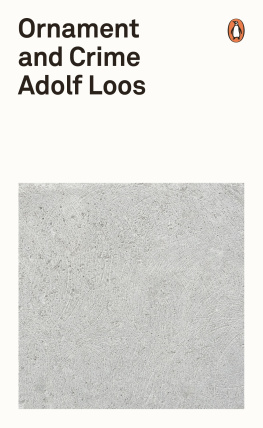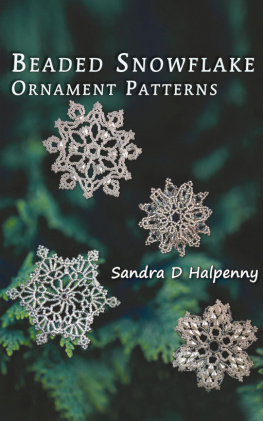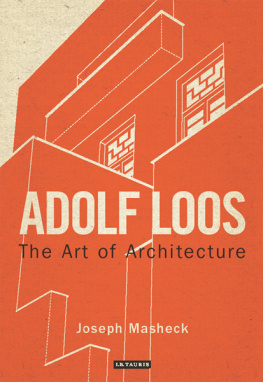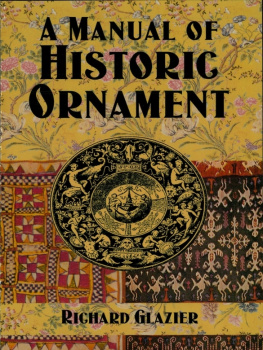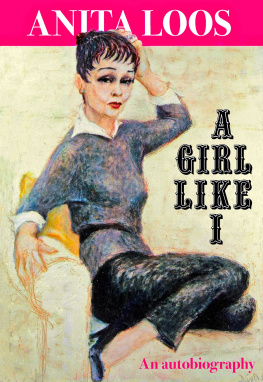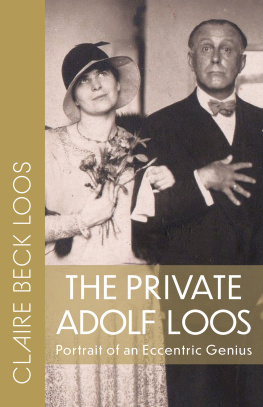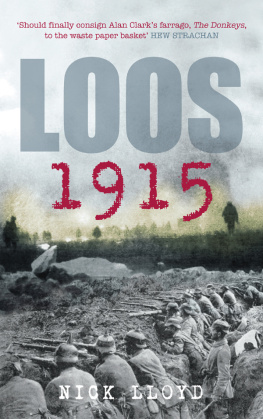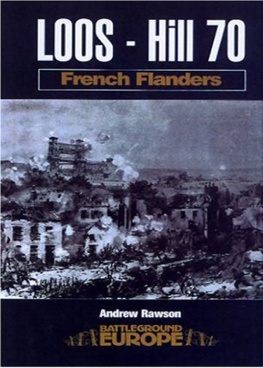Adolf Loos - Ornament and Crime
Here you can read online Adolf Loos - Ornament and Crime full text of the book (entire story) in english for free. Download pdf and epub, get meaning, cover and reviews about this ebook. year: 2019, publisher: Penguin Books Ltd, genre: Romance novel. Description of the work, (preface) as well as reviews are available. Best literature library LitArk.com created for fans of good reading and offers a wide selection of genres:
Romance novel
Science fiction
Adventure
Detective
Science
History
Home and family
Prose
Art
Politics
Computer
Non-fiction
Religion
Business
Children
Humor
Choose a favorite category and find really read worthwhile books. Enjoy immersion in the world of imagination, feel the emotions of the characters or learn something new for yourself, make an fascinating discovery.
- Book:Ornament and Crime
- Author:
- Publisher:Penguin Books Ltd
- Genre:
- Year:2019
- Rating:4 / 5
- Favourites:Add to favourites
- Your mark:
- 80
- 1
- 2
- 3
- 4
- 5
Ornament and Crime: summary, description and annotation
We offer to read an annotation, description, summary or preface (depends on what the author of the book "Ornament and Crime" wrote himself). If you haven't found the necessary information about the book — write in the comments, we will try to find it.
Ornament and Crime — read online for free the complete book (whole text) full work
Below is the text of the book, divided by pages. System saving the place of the last page read, allows you to conveniently read the book "Ornament and Crime" online for free, without having to search again every time where you left off. Put a bookmark, and you can go to the page where you finished reading at any time.
Font size:
Interval:
Bookmark:
Adolf Loos, the great Viennese pioneer of modern architecture, was a hater of the fake, the fussy and the lavishly decorated, and a lover of stripped down, clean simplicity. He was also a writer of effervescent, caustic wit, as shown in this selection of essays on all aspects of design and aesthetics, from cities to glassware, furniture to footwear, architectural training to why the lack of ornament is a sign of intellectual power.

PENGUIN CLASSICS
UK | USA | Canada | Ireland | Australia
India | New Zealand | South Africa
Penguin Books is part of the Penguin Random House group of companies whose addresses can be found at global.penguinrandomhouse.com.

This collection first published in Penguin Classics 2019
Translation copyright Shaun Whiteside, 2019
Critique of Ornament is taken from Adolf Loos: The Art of Architecture by Joseph Masheck and is reproduced courtesy of I.B. Tauris/Bloomsbury Publishing
The moral right of the translator has been asserted
Cover: Detail of Tristan Tzara House by Adolf Loos; photograph by Tom Etherington
Author photograph: akg-images
ISBN: 978-0-141-39298-1
This ebook is copyright material and must not be copied, reproduced, transferred, distributed, leased, licensed or publicly performed or used in any way except as specifically permitted in writing by the publishers, as allowed under the terms and conditions under which it was purchased or as strictly permitted by applicable copyright law. Any unauthorized distribution or use of this text may be a direct infringement of the authors and publishers rights and those responsible may be liable in law accordingly.

The school of the Austrian Museum, our School of Applied Art, has been showing the achievements of the last school year since the 9th of this month. Again we see the usual works, executed with the usual precision, to familiar acclaim in the daily newspapers. And indeed, when we stand in Ferstels solid Italian rooms and consider the still-lifes, the flower paintings, nudes, pictures of the saints, scenes in the style of Tadema, portraits, statues, reliefs, woodcuts, drawings for furniture publications, etc., etc., even the harshest critic among us would be forced to conclude: much has been achieved here. In the school on the Stubenring, painting, sculpture and the graphic arts have something like a secondary Academy. Our Art College on Schillerplatz has a competitor, and even if the accomplishments of that institution cannot be surpassed, because the period of study is too short, this worthy competition has beneficial results. Thus Schillerplatz gets a sharp reminder that it needs to rouse itself from its state of stagnation, and Stubenring turns out second-rate artists. So, one might think, no one should object. That is wrong. Because this race is being run at the expense of something else. And that is applied art, craft.
Let us say it straight out: because of this way of behaving, the applied arts are being actually betrayed. The small sum which, according to the budget for the Ministry of Education, is allocated to education in the applied arts is entirely inadequate for its purpose. We Austrians, who in this regard should be penny-pinchingly frugal because of the inadequate funds, are letting our arts and crafts starve and die at the cost of great art.
This injustice has been committed over the centuries with no one to advocate for our betrayed crafts. For our craftsmen the secret has long been in the open: the workers emerging from this institution are useless for the workshop, for life, for the public. Stuffed full of wrong ideas, without knowledge of material, with a fine sense of imminent nobility, without knowledge of contemporary trends, they either add to the large number of minor painters and sculptors or go abroad to make up for the shortcomings of our own education, if the possibility of assimilation exists. But then they are lost to us. We ourselves cannot take them into the school, we are not strong enough. On the contrary: we expect this institution to provide a stimulus that should set us in motion.
Because we have stagnated for a long time and we are stagnating still. Over the last decade the whole world of the applied arts has taken great strides under Englands leadership. The distance between us and everyone else is becoming ever greater, and it is high time that we took care not to miss our connection. Even Germany has been catching up at a gallop and will soon be joining the victory procession. Such new life abroad! The painters, the sculptors, the architects are leaving their comfortable studios, hanging high art on the peg and taking their place by the anvil, the loom, the potters wheel, the kiln and the carpenters bench! Away with all drawing, away with all paper-based art! What we need to do now is to wrest new forms and lines from life, habits, comfort and utility! Get to it, journeymen, art is something that must be overcome!
In view of this constantly growing enthusiasm for the arts and crafts movement we must deeply regret the fact that our artistic youth stands coldly and apathetically aside. Even those with a calling for it flirt with the fine arts, as we have seen. The reverse, artists returning to craft, is of course not taking place. Is there really so little propensity for enthusiasm among your young people?
But the few works in the exhibition which refer to applied art can already give us an answer to this question. It is as if the pupils own soul were being drawn, corrected, built, modelled and taught out of his body and replaced by a rigid dogma. Nature is studied but without success. Because for the applied arts this study is only a means to an end. But the end that is to be reached is that of stylizing what is present in nature, or rather making it useful to the material from which it is to be formed. But the school lacks the courage and strength as well as the knowledge of material. But the dogma that will inevitably destroy this school is the view that our arts and crafts should be reformed from the top down, from the studio. But revolutions always come from below. And that below is the workshop.
The view still prevails here that the design of a chair should only be entrusted to someone who knows the five orders of columns off by heart. Such a man, I think, would primarily be bound to know something about sitting. But so be it: if it does no good it does no harm either. But no advantage will come from a chair composed in the wrong order of columns. Here I am referring to the entasis of a Doric order, which is constructed like a Roman column. That is a real slap in the face for the Doric spirit. But let us go further than that. The furniture designers who achieve outstanding work as designers of advertisements, a skill that must surely fall within the sphere of graphic art, fail entirely where their own designs are concerned. Ignorance of materials when it comes to copying details from nature we need only consider mouldings that run counter to the techniques of cabinet-making and dull copying, what experts call plagiarism, in the drawings for the decorations of internal spaces are the common features of all three specialist studios in our school. It is not the teacher who should be considered at fault here: it is the spirit that hovers over the whole institution.
Font size:
Interval:
Bookmark:
Similar books «Ornament and Crime»
Look at similar books to Ornament and Crime. We have selected literature similar in name and meaning in the hope of providing readers with more options to find new, interesting, not yet read works.
Discussion, reviews of the book Ornament and Crime and just readers' own opinions. Leave your comments, write what you think about the work, its meaning or the main characters. Specify what exactly you liked and what you didn't like, and why you think so.

